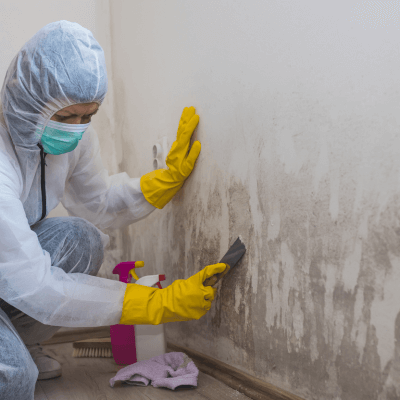Mold Invaders: Decoding Your Mold Report Without the Stress
So, you’ve received your mold report, and now you’re staring at a bunch of numbers and scientific terms that might as well be in a different language. Don’t worry—we’ve got you covered. Mold may be sneaky, but understanding your mold report doesn’t have to be. This guide will break down everything you need to know about reading your mold report, from what those pesky spore counts mean to when you need to call in the pros.
Ready to take action? Contact Howard Environmental for professional mold testing and inspection services in Austin, Texas.
When Should You Test Your Home for Mold?
Is It Time for a Mold Test? Here’s How to Know.
Mold isn’t always as obvious as the creeping black spots on your walls. Sometimes, it hides out in places you’d never think to look, making it all the more important to know when it’s time to get your home tested.
- Unexplained Health Issues: Are you or your family members experiencing allergies, respiratory issues, or unexplained headaches? Mold could be the culprit.
- Visible Mold or Musty Odor: If you can see mold or catch a whiff of that telltale musty smell, it’s definitely time to test.
- Water Damage or Leaks: Past or present water damage is a breeding ground for mold. Even if you can’t see it, it could be lurking beneath the surface.
- Buying or Selling a Home: Mold can kill a deal faster than you can say “inspection.” Whether you’re buying or selling, a mold test is a must.
- Post-Remediation Verification: Just had a mold problem fixed? Make sure it’s truly gone with a follow-up test.
Think you need a mold test? Schedule one today with Howard Environmental.
Mold Tests 101: What Are They, and What Do They Measure?
Air Sampling: What’s in the Air You Breathe?
Sometimes, the mold isn’t just on surfaces—it’s in the air. Air sampling measures the concentration of mold spores floating around, which can be especially important in areas with high humidity or when mold is suspected but not visible.
Surface Sampling: What’s Lurking on Your Walls?
Surface sampling involves swabbing or taping surfaces to identify the specific types of mold growing in your home. This method is handy for visible mold growth or after mold remediation to ensure it’s all been cleared.
Bulk Sampling: Getting Down to the Core
Bulk sampling takes pieces of material from your home—like drywall or insulation—and tests them for mold. This is often used in renovations or in areas with significant damage.
Read More here: Advantages of Hiring a Pro Mold Testing Service.
ERMI and HERTSMI-2: The Moldiness Index Explained
If you’ve ever heard of ERMI (Environmental Relative Moldiness Index) or HERTSMI-2, you know these tests are a bit more technical. They assess your home’s overall moldiness by analyzing dust samples and comparing the types and concentrations of mold to a standardized scale. These tests can be particularly useful for people with mold sensitivities or chronic health conditions.
Decoding Mold Lingo: What All Those Terms Really Mean

Spore Count: Why These Tiny Numbers Matter
Spore counts tell you how many mold spores are present in the sample—think of it like a pollen count but for mold. Higher numbers generally mean more mold, but it’s not just about the count; it’s about the type of mold and where it’s found.
Indoor/Outdoor Comparison: What’s Normal and What’s Not
Your mold report will likely compare indoor spore counts to outdoor ones. Ideally, indoor levels should be lower than or similar to outdoor levels. If they’re higher, it’s a red flag that you’ve got a mold problem inside.
Types of Mold: The Usual Suspects
Not all mold is created equal. Some types, like Cladosporium or Aspergillus, are common and not always harmful, while others, like Stachybotrys (aka black mold), can be more serious. Your mold report will list the types found, so you can understand the potential risks.
Raw Count vs. Spore Estimate: What’s the Difference?
The raw count gives you the actual number of spores found, while the spore estimate considers the likely number of spores based on the sample size. Both numbers are important, but the spore estimate can provide a more accurate picture of your home’s mold levels.
Breaking Down Your Mold Report: What It All Means for You
What’s Hiding in Your Home? Types of Mold to Watch Out For
Your report will list the types of mold found in your samples. In Austin, you might encounter molds like Penicillium, Aspergillus, and Alternaria. Some are harmless in small quantities, while others could spell trouble.
Spore Concentration Levels: High, Moderate, or Low?
The spore concentration levels in your report tell you how much mold is in the air or on surfaces. High levels usually mean you’ve got a mold problem that needs attention, while moderate or low levels might just require monitoring.
Indoor vs. Outdoor Mold Levels: When to Worry
If your indoor mold levels are significantly higher than the outdoor ones, it’s a sign that mold is thriving in your home. This is especially concerning if you have types of mold indoors that aren’t present outdoors.
Where’s the Mold? The Importance of Sample Locations
The location of your mold samples can reveal a lot. For example, high mold levels in a bedroom could indicate a ventilation issue, while a concentration in the basement might point to water damage.
What’s an Acceptable Mold Score? Understanding the Numbers
There’s no one-size-fits-all answer when it comes to acceptable mold levels. What’s “acceptable” depends on factors like the types of mold, their concentrations, and whether anyone in the home has mold sensitivities. Context is key here—don’t panic if you see numbers that seem high. Instead, focus on the type of mold and its potential health impacts.
Next Steps: What to Do After Reading Your Mold Report

When to Call in the Pros: Don’t Go It Alone
If your mold report shows high levels of harmful mold or if you’re unsure what to do next, it’s time to bring in the professionals. Certain types of mold, like black mold, should always be handled by experts to ensure your home is safe and mold-free.
DIY vs. Professional Mold Remediation: What You Can Handle and What You Can’t
For small areas of mold, you might be able to tackle the cleanup yourself with the right tools and safety gear. But for larger infestations or certain mold types, professional remediation is crucial. Remember, after remediation, follow-up testing is essential to confirm that the mold is gone.
Where to Find More Information
If you’re interested in learning more about mold testing and what to do if your mold test comes back positive, check out this EPA guide on mold remediation.
FAQ: Your Mold Report Questions Answered
What is an acceptable mold score? An acceptable mold score depends on the types of mold, their concentrations, and the context of your home environment. There’s no universal “safe” level, but generally, lower is better.
How do I read a mold analysis report? Start by identifying the types of mold and their spore counts. Compare indoor and outdoor levels, and consider the locations of the samples. If in doubt, consult a professional for interpretation.
What are normal mold test results? Normal results typically show low to moderate levels of common molds, with indoor levels similar to or lower than outdoor levels.
What is considered “good” mold? There’s no “good” mold, but some types, like Cladosporium, are less harmful than others. What matters more is the concentration and location of the mold.
How do I read mycotoxin test results? Mycotoxins are toxic substances produced by certain molds. If your test shows mycotoxins, it’s important to consult with a professional, as they can be harmful even in small amounts.
Wrapping Up: Your Mold Report Decoded
Understanding your mold report is the first step in keeping your home safe and healthy. Whether you’ve found a little mold or a lot, knowing what to do next is key. Don’t leave your home’s safety to chance—schedule a comprehensive mold inspection with Howard Environmental today.

